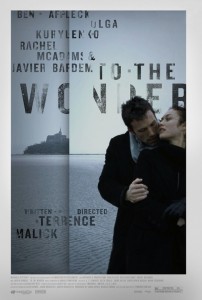
Director: Terrence Malick
MPAA Rating: R
Film Pulse Score: 5/10
What to make of Terrence Malick’s latest film To the Wonder? After making what some consider to be a master work, The Tree of Life, the only logical step is down, right? Or is it for those who didn’t think much of it the only logical step is up? More to the point after a film like The Tree of Life it is no surprise that before seeing To the Wonder you may find yourself pondering just what will this new film mean. Surprisingly there isn’t any deep philosophical meaning wrapped up in a dream-like enigma this time out. While still maintaining that dream-like quality the narrative is fairly straight forward. Now a new question emerges. In the end, will anyone even care?
To the Wonder seems to be the most eloquent, beautifully photographed, ethereal film about the hopeful longing and search for a meaningful relationship and the eventual disintegration of said relationship but despite all this there’s still hope in the end. That interpretation may be completely off base but for this viewer that’s what was taken away from it upon completion. Pessimistic to be sure but at least Malick did leave room for optimism.
The film follows Neil and Maria, a couple in love who are traveling Europe. Neil whisks Maria and her daughter away to the States. All seems to go swimmingly until Neil begins losing interest and drifts away. After immigration issues arise they split and she heads back to Europe. Neil reconnects with an old friend, Jane, who like Maria longs for a meaningful relationship. However, when Maria says she is coming back matters become complicated. Meanwhile, Father Quintana a priest who is losing his faith finds himself hypocritically preaching about relationships and the importance of trust and loyalty in the religious context of course. The film is nearly bereft of dialogue with the exception of voiceovers by the four main characters spouting poetic-like sentiments that often seem to be fit for a Hallmark card.
Performance wise everyone is good. In a film that has minimal dialogue it really relies on the actors to convey the emotion and propel the story. They do a fine job of conveying the joy, the confusion, the loss and the heartbreak. However unfortunately the story, once you remove the Malick influences, is fairly generic and you aren’t invested in the character’s plight. As mentioned before it’s boy meets girl, boy loses girl, boy gets girl back, boy loses girl again and so on and so forth.
Beautifully photographed by Emmanuel Lubezki, Malick once again paints a pretty picture with deliberate and sometimes uneven strokes. It would appear that ultimately he wasn’t able to fill the entire canvas or the picture he was painting didn’t quite turn out the way he wanted and he decided to move on. Malick is known for taking long periods of time between films, it’s been two years since his last, so perhaps he was a bit rushed before he allowed this idea to truly blossom. I guess we will never know since he’s already moved on to his next project.






